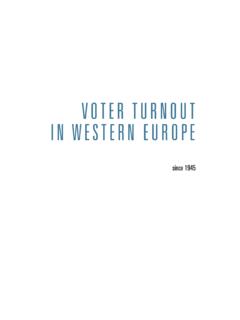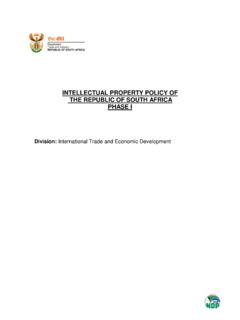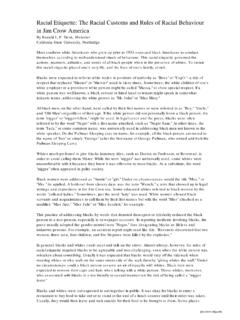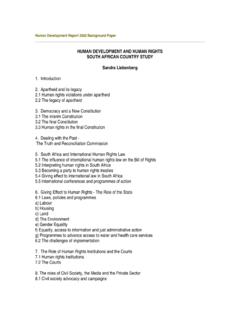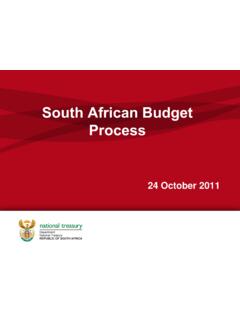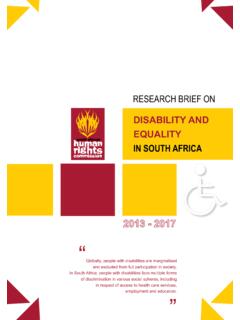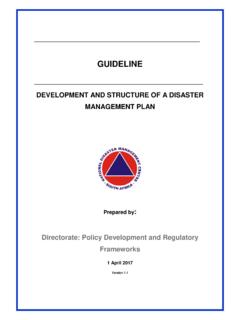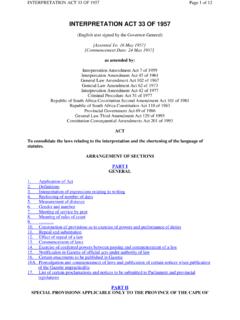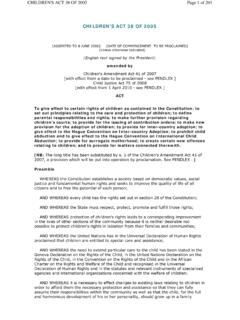Transcription of Impact of COVID-19 on the 2020 US presidential election
1 Impact of COVID-19 on the 2020 US presidential electionCase Study, 20 November 2020 Kate Sullivan 2020 International Institute for Democracy and Electoral Assistance International IDEA publications are independent of specific national or political interests. Views expressed in this publication do not necessarily represent the views of International IDEA, its Board or its Council electronic version of this publication is available under a Creative Commons Attribution-NonCommercial-ShareAlike (CC BY-NC-SA ) licence. You are free to copy, distribute and transmit the publication as well as to remix and adapt it, provided it is only for non-commercial purposes, that you appropriately attribute the publication, and that you distribute it under an identical licence.
2 For more information visit the Creative Commons website: <http:// >International IDEA Str msborg SE 103 34 Stockholm Sweden Telephone: +46 8 698 37 00 Email: Website: < > This case study is part of a collaborative project between the Electoral Management Network <http:// > and International IDEA, edited by Toby S. James (University of East Anglia), Alistair Clark (Newcastle University) and Erik Asplund (International IDEA).Created with Booktype: < >International IDEAI mpact of COVID-19 on the 2020 US presidential election .. 51. Introduction.
3 52. Background .. 53. COVID-19 in the United States .. 64. Holding the election .. 75. Litigating the election .. 86. Financing the election .. 87. Voter Registration .. 98. The electoral campaign .. 109. Voter arrangements .. 1110. A politicized response to voting during COVID-19 .. 1811. Lessons learned .. 18 References .. 22 Further reading .. 29 About the author .. 30 About International IDEA .. 30 ContentsInternational IDEA 5 Impact of COVID-19 on the 2020 US presidential electionImpact of COVID-19 on the 2020 US presidential electionKate Sullivan 1. IntroductionThis case study looks at how the administration and environment of the 2020 US presidential election was affected by the onset of the COVID-19 pandemic.
4 US presidential elections are in reality more than 50 separate elections, and held concurrently with elections for a wide variety of other federal, state and local offices, along with referendums or ballot measures. Unsurprisingly then, the study shows that there was no unified response to the specifically noted, this case study does not examine the Impact of the pandemic on the political party nominating contests, or other federal and state elections. The study notes the Impact of the pandemic on various elements of the electoral process and details what actions were taken to provide open but safe participation and access in the face of the elections were delivered relatively smoothly (and with notable turnout), but in an environment of continued uncertainty as to what arrangements to make and how they would be funded, and with repeated recourse to litigation.
5 The large rise in postal voting and the expanded provision of early voting saw voters have access to a range of voting channels, allowing them to choose the one that best suited their (COVID-altered) circumstances. Being able to deliver such choice, albeit in an acrimonious and tense political environment, is a real achievement for US electoral study was written while vote counting, post- election processing and electoral litigation were ongoing in several states. While individual statistics cited herein may change, the trends relied upon will not. 2. BackgroundIn the United States, there is no uniformity in electoral arrangements for federal elections; powers to make laws and rules for federal electoral administration are dispersed between 6 International IDEAI mpact of COVID-19 on the 2020 US presidential electionfederal, state and local governments.
6 The US Congress has some power to mandate electoral arrangements for federal offices, and they have done so in the case of some aspects of voter registration and polling arrangements for members of the military and US citizens abroad. This dispersal of policy-setting, decision-making and funding responsibilities, and the heightened partisan divisions in present-day US politics, meant that a unified response to the COVID-19 epidemic proved hard to reach in many , there are communities of practice within US electoral administration, and there has been sharing of COVID-19 experience and resources within and across states.
7 The federal election Assistance Commission did make efforts to share information on how to deliver COVID-secure elections, though with some criticism (Huseman 2020) that they were passing on others information rather than generating tailored guidance fragmentation of decision-making is exacerbated by the partisan nature of decision- making. Of course, it is a fact the world over that electoral laws are made by legislatures that have been elected on a partisan basis. However, implementation is then often handed over to non-partisan administration: independent electoral management bodies are a feature of arrangements in 137 countries (64 per cent) around the world (International IDEA ).
8 In the USA, partisan implementation of electoral laws is built into the system, either through the use of an elected official as a state s chief electoral officer (NCSL 2020a), as occurs in 26 states; or through the use of partisan-based oversight boards and are two federal commissions related to electoral matters the Federal election Commission (FEC), which has oversight of federal political finance matters, and the Electoral Administration Commission (EAC), which has an advisory and sometimes a funding role both of whose statutes require appointment of commissioners on an equal partisan USA also has an unfortunate history of using discriminatory electoral arrangements to exert political and societal control over minority groups, and for the achievement of electoral outcomes that amplify the societal position of the majority group.
9 In many parts of the country, especially the Jim Crow south , blatant and deliberate exclusion of african -American citizens from the electoral process (including for partisan motives) was practised up until the passage of major civil rights legislation in the 1960s and various organisations (Brennan Center for Justice ) have detailed modern practice and policy that achieves the same US Constitution stipulates a four-year presidential term, and federal statute sets a uniform voting day. In 2020, the incumbent President Donald Trump of the Republican Party stood for re- election .
10 His main challenger was former Vice-President Joe Biden of the Democratic Party. A variety of other candidates appeared on presidential ballot papers in some states, including candidates from the Green Party and the Libertarian Party (Ballotpedia ); however, the two major parties have held a duopoly on the first and second places in presidential elections since 1916. Prior to the election , Mr Trump s Republican Party held a majority in the Senate, and the Democratic Party the majority in the US House of Representatives; 33 Senate seats were to be elected in 2020, and all 435 House seats.


